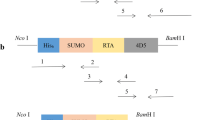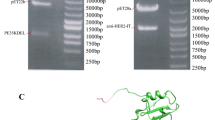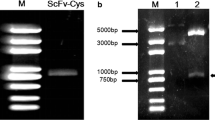Abstract
Targeted immunotherapy has become a popular research topic in cancer. The development and metastasis of cervical carcinoma are closely related to epidermal growth factor (EGF) and EGF-1 receptor (EGFR). We successfully constructed a single-chain human anti-EGFR antibody (scFv) and truncated protamine (tP) fusion protein (scFV/tP) expression vector using overlap extension PCR. Enzyme-linked immunosorbent assay and gel shift assay showed that the fusion protein retained the DNA and antigen-binding activity of the original antibody. Using the non-viral scFv/tP vector as a delivery tool, small interfering RNA (siRNA) of the human wings apart-like gene (hWAPL) was effectively transfected into cervical cancer HeLa cells. The hWAPL mRNA expression levels were reduced by 97.23 % in contrast with control cells, and the proliferation capability declined by 66.71 %, indicating significant inhibition. The present results provide a novel strategy for targeted gene therapy and siRNA therapy of EGFR-positive cervical cancers.






Similar content being viewed by others
References
Sundström K, Eloranta S, Sparén P et al (2010) Prospective study of human papillomavirus (HPV) types, HPV persistence, and risk of squamous cell carcinoma. Cancer Epidemiol Biomarkers Prev 19:2469–2478
Kuroda M, Kiyono T, Oikawa K et al (2005) The human papillomavirus E6 and E7 inducible oncogene, hWAPL, exhibits potential as a therapeutic target. Br J Cancer 92:290–293
Oikawa K, Akiyoshi A, Tanaka M et al (2008) Expression of various types of alternatively spliced WAPL transcripts in human cervical epithelia. Gene 423:57–62
Soonthornthum T, Arias-Pulido H, Joste N et al (2011) Epidermal growth factor receptor as a biomarker for cervical cancer. Ann Oncol 22:2166–2178
Lin H, Mao Y, Zhang DW et al (2013) Selection and characterization of human anti-MAGE-A1 scFv and immunotoxin. Anticancer Agents Med Chem 13:1259–1266
Inoh Y, Furuno T, Hirashima N et al (2013) Synergistic effect of a biosurfactant and protamine on gene transfection efficiency. Eur J Pharm Sci 49:1–9
Zhang F, Wang X, Tang Q et al (2011) Preparation and characterization of human anti-EGFR scFv–protamine fusion protein. Acta Universitatis Medicinalis Nanjing (Nat Sci) 31:651–655
Nieder C, Pawinski A, Dalhaug A et al (2012) A review of clinical trials of cetuximab combined with radiotherapy for non-small cell lung cancer. Radiat Oncol 7:3
Steele N, Anthony A, Saunders M et al (2012) A phase 1 trial of recombinant human IL-21 in combination with cetuximab in patients with metastatic colorectal cancer. Br J Cancer 106:793–798
Chen R, Zhang D, Mao Y et al (2012) A human Fab-based immunoconjugate specific for the LMP1 extracellular domain inhibits nasopharyngeal carcinoma growth in vitro and in vivo. Mol Cancer Ther 11:594–603
Bebb G, Smith C, Rorke S et al (2011) Phase I clinical trial of the anti-EGFR monoclonal antibody nimotuzumab with concurrent external thoracic radiotherapy in Canadian patients diagnosed with stage IIb, III or IV non-small cell lung cancer unsuitable for radical therapy. Cancer Chemother Pharmacol 67:837–845
Kato J, O’Donnell RT, Abuhay M et al (2012) Efficacy and toxicity of a CD22-targeted antibody–saporin conjugate in a xenograft model of non-Hodgkin’s lymphoma. Oncoimmunology 1:1469–1475
Lu D, Zhu Z (2014) Construction and production of an IgG-like tetravalent bispecific antibody, IgG-single-chain Fv fusion. Methods Mol Biol 1060:185–213
Chen ZN, Mi L, Xu J et al (2006) Targeting radioimmunotherapy of hepatocellular carcinoma with iodine (131I) metuximab injection: clinical phase I/II trials. Int J Radiat Oncol Biol Phys 65:435–444
Parodi G, De Luca G, Moschi G et al (2010) Safety of immediate reversal of anticoagulation by protamine to reduce bleeding complications after infarct artery stenting for acute myocardial infarction and adjunctive abciximab therapy. J Thromb Thrombolysis 30:446–451
Ortner A, Wernig K, Kaisler R et al (2010) VPAC receptor mediated tumor cell targeting by protamine based nanoparticles. J Drug Target 18:457–467
Cao M, Deng X, Su S et al (2013) Protamine sulfate-nanodiamond hybrid nanoparticles as a vector for MiR-203 restoration in esophageal carcinoma cells. Nanoscale 5:12120–12125
Hao H, Zhen Y, Wang Z et al (2013) A novel therapeutic drug for colon cancer: EpCAM scFv-truncated protamine (tp)-siRNA. Cell Biol Int 37:860–864
Song E, Zhu P, Lee SK et al (2005) Antibody mediated in vivo delivery of small interfering RNAs via cell-surface receptors. Nat Biotechnol 23:709–717
Acknowledgments
This work was supported by grants from the Medical Science and Technique Development Fund, Nanjing, Jiangsu, China (No. ZKX09015), the Nanjing Municipal Science and Technology Commission, Jiangsu, China (No. 20120825), the Medical Science and Technique Development Fund, Nanjing, Jiangsu, China (No. ZKX12025) and the National Natural Science Foundation for Youth of China, China (No. 81301951).
Conflict of interest
The authors declare that they have no competing interests.
Author information
Authors and Affiliations
Corresponding authors
Additional information
Huilin Zhang and Yuan Mao contributed equally to this work.
Rights and permissions
About this article
Cite this article
Zhang, H., Mao, Y., Zhang, F. et al. The inhibitory effect of a new scFv/tP protein as siRNA delivery system to target hWAPL in cervical carcinoma. Mol Cell Biochem 391, 77–84 (2014). https://doi.org/10.1007/s11010-014-1989-3
Received:
Accepted:
Published:
Issue Date:
DOI: https://doi.org/10.1007/s11010-014-1989-3




